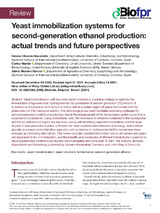Yeast immobilization systems for second-generation ethanol production: actual trends and future perspectives
Autor
Chacón-Navarrete, Helena
Martín, Carlos
Moreno-García, Jaime
Editor
WileyFecha
2021Materia
Yeast immobilizationYeast
Alcoholic fermentation
Second-generation ethanol
METS:
Mostrar el registro METSPREMIS:
Mostrar el registro PREMISMetadatos
Mostrar el registro completo del ítemResumen
Yeast immobilization with low-cost carrier materials is a suitable strategy to optimize the fermentation of lignocellulosic hydrolysates for the production of second-generation (2G) ethanol. It is defined as the physical confinement of intact cells to a certain region of space (the carrier) with the preservation of their biological activity. This technological approach facilitates promising strategies for second-generation bioethanol production due to the enhancement of the fermentation performance that is expected to be achieved. Using immobilized cells, the resistance to inhibitors contained in the hydrolysates and the co-utilization of sugars are improved, along with facilitating separation operations and the reuse of yeast in new production cycles. Until now, the most common immobilization technology used calcium alginate as a yeast carrier but other supports such as biochar or multispecies biofilm membranes have emerged as interesting alternatives. This review compiles updated information about cell carriers and yeast-cell requirements for immobilization, and the benefits and drawbacks of different immobilization systems for second-generation bioethanol production are investigated and compared. © 2021 The Authors. Biofuels, Bioproducts and Biorefining published by Society of Industrial Chemistry and John Wiley & Sons Ltd.

